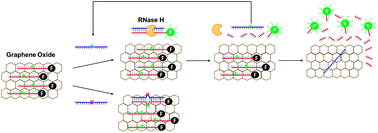Isothermal control of probe–target interactions using graphene oxide and a nuclease for highly sensitive and specific detection of target DNA†
Abstract
Herein, a method to control interactions between RNA probes and DNA targets using graphene oxide and RNase H was developed for the highly sensitive and specific detection of target DNA without a thermal cycler. This strategy used graphene oxide for selective coupling between the probe–target hybrids and RNase H for detaching target DNA coupled with fluorescent labeled RNA probes. Graphene oxide and RNase H exhibited strong affinity and selectivity towards single stranded DNA or RNA and the RNA in DNA–RNA duplexes, respectively. The coupled RNA probes with perfectly matched target DNA were digested by RNase H, freeing the target DNA to form multiple hybrids. Due to the highly efficient fluorescence quenching by graphene oxide, the fluorescence was turned on as the labeled probes were digested in the presence of the target DNA, while no significant fluorescence was observed even with single base mismatched DNA sequences. To maximize the fluorescence amplification and the number of digested RNA probes, the amount of graphene oxide and RNase H was optimized (10 μg mL−1 and 2 U μL−1, respectively). The optimized control of the interactions allowed recycling of the target DNA and the digestion of nearly 10 000 RNA probes per target DNA within 30 min without a thermal cycler, as the reaction was performed at 37 °C. As a result, we could detect target DNA in amounts as low as 2 attomoles.



 Please wait while we load your content...
Please wait while we load your content...